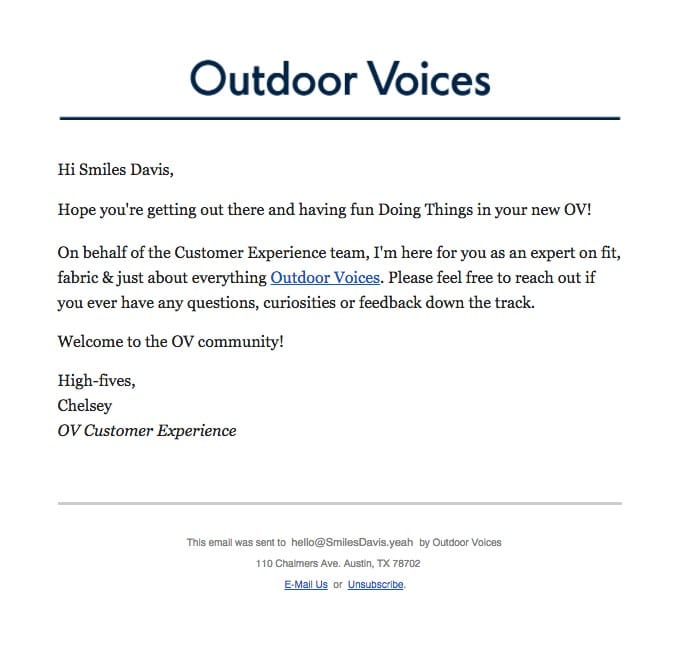This post has been updated as of May 2019
Our team has had a bit of a bug-bear for a while now: the no-reply email address. Despite countless companies (including loads of the bigger ones) sending newsletters and autoresponders from [email protected], we just have to speak up here:
Sending from a no-reply address simply comes across as uncaring to subscribers and may even be bad news for delivery rates in the long term.
So. when we came across a plainly worded blog post by Joss Crowcroft titled “Death to the ‘no-reply’ mailbox,” we collectively felt his pain. In his words:
It astounds me that in 2011, startups and companies are sending out automated emails with no-reply email addresses. It basically says to the recipient:
“I’m not interested in hearing from you by email, regardless of whether email is better or easier for you. I just don’t respect you enough to take the risk that a dozen people might reply and insult me.”
Why using a no-reply address is an email marketing don’t
As we’ll discuss in a moment, the issue here is not just an emotional one —there are other solid reasons for making yourself available via email.
From no-reply to please-reply
Second to showing respect, providing an email address that’s linked to a real, live inbox also shows that you’re open for business. Although putting an email address out there may attract its fair share of auto-replies, chances are that there will also be useful, relevant messages, like:
“I really enjoyed your latest email news. Can you provide us with a quote for a similar template?”
“What are your opening hours? I’d love to drop by sometime.”
“I’m changing my email address, but still want to get your updates. Can you help me out?”
This is the sort behavior that email senders should really encourage, especially if they don’t have a fancy call center or real-world presence. It’s not just being nice—replies are a valuable source of feedback and a chance to connect. Or, as a commenter on Hacker News put it elegantly:
“EVERY email you send should be considered an opportunity to increase engagement with your users. Tell them that they can respond with questions, comments, whatever.”
It’s also an opportunity to remain in Google and Yahoo’s email delivery good books.
A relationship between replies and delivery rates?
Our friends at MarketingSherpa provided a rare insight into how Gmail ranks the “importance” of email based on recipient actions like opens and replies. In a recent post on the algorithm behind their Priority Inbox feature, they linked to a research paper by Google, which, amidst dense clusters of math, features this lucid statement:
“Importance ground truth is based on how the user interacts with a mail after delivery.”
Or, in human terms: If recipients reply to your emails, then Gmail is more likely to consider them to be important.
It’s not far-fetched to imagine that Gmail applies a similar algorithm overall to determine whether an email is worthy of landing in the inbox (rather than junk mail). So replies are to be encouraged, not shooed away.
ReturnPath also make a similar claim in their “Field Guide to Yahoo! Inboxes.” As deliverability experts, they use no uncertain terms in linking engagement (opens, clicks, and replies) with inbox delivery rates:
“Engagement has always been an important measure of subscriber interest for senders, but ISPs are starting to make significant investments in research, in-house spam filters and third-party software to help measure subscriber engagement to better determine appropriate folder placement… Inactive subscribers will ultimately hurt your ability to get delivered.”
So not only is sending from a no-reply address an effective way to hurt feelings, but it can also take a chunk out of your delivery rates too.
But I don’t like getting bombarded with Out-of-Office replies
A common reason for using a no-reply address is that it’s too difficult to manage the tsunami of automated responses that follow each email send. Messages like delivery failure notifications, or “So-and-so is out of the office.”
Thankfully, there are automated ways to handle responses, many of which don’t take much effort to set up. For example, forwarding replies to a Gmail account can be particularly effective, as not only does it handle spam particularly well (an unfortunate consequence of putting an email address out there), but you can set up filters/rules to keep human and robot responses apart, as well as create automated responses.
Specifics on how to separate useful emails from the useless auto-replies and miscellanea that stream in after every send will be the subject matter of an upcoming blog post, so stay tuned for more on this topic.
The moral of the story is that sending from a no-reply address can also affect not just customer relationships, but sender reputation with Gmail and other email clients. For some folks, sifting through replies may seem like a tedious administrative task, but, for the rest of us, it’s a great opportunity to maintain high delivery rates and provide solid customer service—both of which should be important objectives in any email marketing strategy.
The human side of email
One of the most important things to remember in email marketing is that a human approach is highly valued by customers. That means that customers don’t want extraordinarily impersonal communications with the brands they do business with. Just because you’re a business doesn’t mean that you have to be businesslike or clinical to the point that it can be perceived as cold or uncaring by the customer.
Adding a human touch goes hand in hand with personalization and paying more attention to customers’ needs and their abilities to potentially promote your brand. Never discount a customer as a possible brand ambassador. You should put as much work into your customers as you do in making your products or delivering your services.
Every single email between your brand and your customers represents an opportunity to increase customer engagement.
Naturally, one of the first places to start when adding some personalization to your emails is in the subject line. Remember, the subject line is one of the single most important components of email in marketing. The contents of that one line affect the likelihood of your customers opening it.
The next layer of personalization starts with the greeting. You should always include the names of your customers in every email that’s sent. Failure to do so can make customers feel unappreciated or like a statistic. Prove them wrong by including their name and also adding some personal touches to the email.
The basic components of your emails aren’t the only things that matter. Be sure to make an effort to supply personalized images and offers when emailing your customers, especially when it comes to newsletters. Subscribers deserve specialized content that’s relatively exclusive to give them enough incentive to want to keep subscribing to your newsletters.
The importance of personalization in customer service emails
Customer service emails are another area where personalization is key. Today’s consumer abhors being paired up with a robot or otherwise automated manifestation of customer service, especially when communicating via email.
Not only is an automatic response insulting, but they can be inaccurate and ultimately incapable of resolving the customer’s needs. All of this points to the importance of maintaining personalized customer service.
You need to make it not only possible, but reasonably simple to reach an actual human when subscribers engage with email-based customer service through your brand. Be sure not to use no-reply-based emails because it’s a wasted opportunity for the kind of customer engagement you could generate.

Source: Really Good Emails
What happens if you send an email to a no-reply?
On your end, nothing will happen. You will not receive the reply. Using a no-reply email address means that your customers won’t be able to send emails back to you, and, in turn, can cause bottlenecks in communication.
A no-reply email is generally frowned upon by customers seeking richer experiences. These emails are wasted communication in business because there’s no excuse to not facilitate replies to customer emails. Customers expect superior customer services brands, and, if they don’t find that with your company, they’ll look elsewhere.
Wrap up
The key here is to look at the big picture. Today’s customers crave personalization, which can be useful to increase customer engagement. You should steer clear of using no-reply emails, as they waste opportunities for richer interaction with customers.
Learn more best practices in email marketing with Campaign Monitor.
This article was originally posted in August 2011





